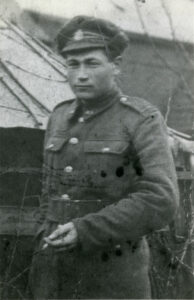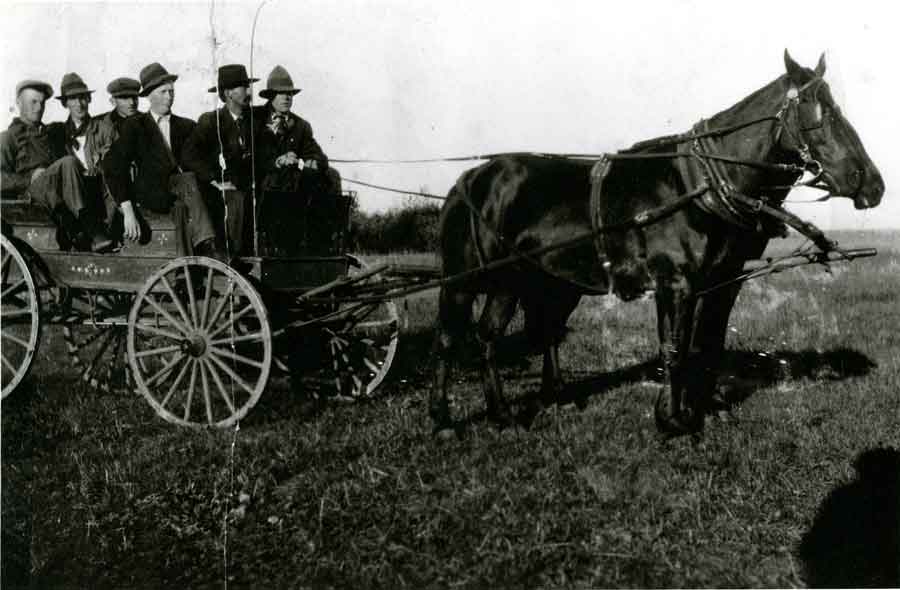Image: A group of six men traveling by horse and wagon from Grande Prairie to Athabasca to enlist with the R.N.W.M.P. at the beginning of WWI. Harlie Conrad, who later served with the CFC, is at the far left. 1914 (SPRA 356.03.08)
With Remembrance Day just around the corner, we’re revisiting a past Telling Our Stories article about the Canadian Forestry Corps in World War I. This article was contributed by Archives volunteer Kaylee Dyck and appeared in the March 2020 issue. Kaylee researched First World War veterans of the South Peace in order to complete the Archives’ online World War I Soldier’s Memorial.
Forests play a crucial role in Canada’s history and economy. In times of war, this has been particularly true; after all, 40% of Canada is wooded land. During the Napoleonic Wars, Britain imported tremendous amounts of timber from Canada to build up the Royal Navy. When the Great War began, Britain wanted not only the timber, but Canada’s lumbermen as well.
At the start of the war, timber was shipped across the Atlantic. However, limited space aboard existing ships and the threat of U-boat attacks prompted change. In February of 1916, the British government requested that 1,500 skilled lumbermen be sent from Canada to harvest forests in England and Scotland (and, later, in France). The 224th Battalion produced its first sawn lumber in England within three months. It soon became apparent that more than one battalion would be needed to keep up with the demands of war. On November 14, 1916, the Canadian Forestry Corps (CFC) was officially established. By the end of the war, the CFC was a force of over 30,000 men, including some foreign labourers and German POWs.
When the CFC was first formed, the army preferred experienced men like Jack Cummins, who homesteaded between Sexsmith and La Glace after the war. Jack had been logging in British Columbia when he decided to join the CFC, and he was assigned to a company in France. In August 1918, he was one of 1,300 forestry men who volunteered for active service in aid of the final push that led to the end of the war.
As the war dragged on, the CFC needed more and more men. Men previously deemed unfit for active service at the front lines were now welcomed to the CFC. Many lied about their age, desperate to “do their bit.” William Paige of East Pouce Coupe gave his age as 17 when he enlisted, and though the recruitment officer believed him to be even younger, William was able to join the CFC. At the opposite end of the spectrum were those who were overage but unwilling to let the young fellows do all the work. Omer Dupont of Goodfare was 54 years of age when he was enlisted (he claimed to be ten years younger). Omer served with the CFC until April of 1918, despite suffering from rheumatism. Herman Klukas was transferred to the Corps after sustaining injuries at Passchendaele and Ypres. Flat feet and the lingering effects of a gas attack landed Walter Bowen, a Beaverlodge farmer, in the Forestry Corps. This motley crew of the too-young, too-old, and injured would disprove the critics and become the backbone of the Allied effort.
The CFC produced an estimated 70% of all Allied lumber during the war. This lumber was used to construct trenches, duck boards, telegraph poles, troop shelters, ammunition boxes, aircraft, guns, rail lines, bridges, roads, and countless other necessities of war. The CFC operated 151 logging camps in Britain and France, and was made up almost entirely of Canadian men, machinery, and methods. In most cases, locals greatly admired these hardworking lumbermen. The press described them as having “the bronzed, healthy look and the easy confident swing which we have learned to look for in Canadians.” The royals too were great supporters of the Forestry Corps; Princess Anne acted as an informal patron, and King George V donated Windsor Great Forest to the war effort.
Over time, the CFC became more sophisticated. In 1917, the CFC began to farm its own plots of land in order to become more self-sufficient, rather than taking valuable rations away from those at the front. Also that year, a training camp was opened for the men who had no previous experience in the logging industry. No amount of training or experience, however, could prevent accidents. Two South Peace men, Herbert Stewart and Thomas Rice, sustained injuries while serving with the CFC. Herbert joined the Forestry Corps in England after receiving shrapnel wounds and showing signs of shell shock. In March of 1918, a log fell from a wagon onto his leg, causing a serious fracture and resulting in a permanent limp. Thomas’s injury was less serious; he slipped on ice and his foot became “jammed between the log and the carriage and the skidway.”
By the end of the war, at least 75 men from the South Peace region had served with the Forestry Corps. For some, serving in the CFC marked the beginning of a new path in life. George Nowry, once a barber, used the skills he had learned during the war to take over a sawmill in Grande Prairie in 1921. Researchers can visit the Archives’ online Soldiers’ Memorial to learn about Nowry and others who served in the Canadian Forestry Corps. A list of local CFC veterans can be viewed on the Archives’ blog.
Without the work of the Canadian Forestry Corps, the Allies would have suffered from a serious lack of supplies. The outcome of the war might have been very different without their efforts. While most of those who served far behind the front lines were spared from the atrocities that the soldiers in the trenches witnessed, the labour and dedication of these Sawdust Fusiliers was no less significant.

